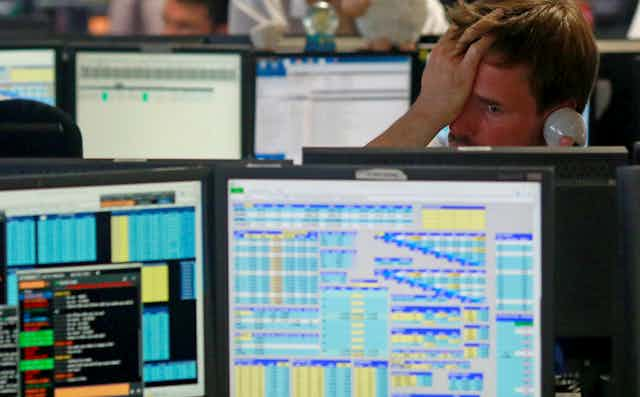Uncertainty about future policy decisions is often identified as major drag on a country’s economy. Uncertainty about interest rate movements, for example, may see households postpone their consumption, and entrepreneurs wait and see before investing in a business. As a result, aggregate demand naturally weakens, and the economy slows down.
But how relevant is uncertainty, really?
Economists need measures of uncertainty to quantify its impact on the business cycle of a country. A trio of US based economists - Scott Baker (Northwestern University), Nicholas Bloom (Stanford University), and Steven Davis (University of Chicago) recently developed an index of Economic Policy Uncertainty (EPU) for a variety of countries, including Australia.
To create the index, they select country-specific newspapers and perform a search for keywords that are associated with the economy, policy decisions, and uncertainty surrounding such decisions. To the extent that newspapers offer information on perceptions of uncertainty by households and entrepreneurs in that country, this index can be fruitfully used to assess the macroeconomic consequences of spikes in uncertainty.
The graph below depicts the evolution of the Australian EPU since 1997.

Spikes in this index are mostly associated to external events such as 9/11, the second Gulf War, the bankruptcy of Lehman Brothers due to the US sub-prime mortgage crisis, the US debt ceiling dispute, and more recently, Brexit.
Domestic political events also increase the value of the index. Some of the jumps in this EPU index are significant, the largest one corresponding to the Brexit referendum in June 2016. The researchers interpret these spikes as jumps in uncertainty over the policy response of the Reserve Bank of Australia and/or the Treasury to these external and internal events.
But Australia’s economy remains strong…
In spite of these fluctuations in uncertainty, however, not much has been going on in the Australian business cycle.
The last official recession in Australia occurred in the early 1990s. Recent figures point to a yearly growth rate of Australia’s real GDP of 3.3%, much larger than that of most industrialised countries in the world.
And Australia’s future is reasonably bright. According to the Reserve Bank of Australia governor Philip Lowe:
Domestic demand is expected to strengthen gradually as the drag on our economy from the decline in mining investment comes to an end. […] Some pick-up in wages and prices could then be expected. In addition, commodity prices, after having declined over the preceding four years, have increased this year. If sustained, this will boost national income and falls in petrol prices will no longer be having a significant effect on headline inflation.
Recent research conducted by RBA economists makes use of econometric models suited to isolate the role of uncertainty and its impact on Australia’s real activity.
Such research finds uncertainty exerts a negative but fairly small effect on domestic investment and employment growth.
So, why hasn’t uncertainty affected Australia’s economy much?
In work conducted with a pool of researchers based at the Melbourne Institute, I found that jumps in uncertainty are particularly harmful for a country’s growth if they hit a country already experiencing a downturn.
The “uncertainty-recession” multiplier – the negative effects on the overall production of a country due to jumps in uncertainty occurring during a recession – is found to be much larger than the “uncertainty-expansion” multiplier (the negative effects when a country is in a boom).
Intuitively, a reduction in confidence (which is akin to an increase in uncertainty) is likely to more severely affect households and entrepreneurs when a slowdown in economic activity is already underway.
Committing to purchase a car or invest in a new machine can be very costly if economic conditions worsen in future. Reselling a car to pay for rent, clothing or food would likely turn out to be a capital loss, more than a capital gain. And why should entrepreneurs buy a new machine during a recession characterised by high uncertainty? Better to wait until the smoke clears.
On the other hand, during an economic boom any effects of jumps in uncertainty are likely to be (at least) partly offset by expectations of high returns from investment. This means there may not necessarily be a reduction in how optimistic households are, or their consumption.
Monetary policy may also help explain why jumps in uncertainty may be more relevant in other countries than in Australia. Reductions in short-term interest rates can alleviate the negative effects of jumps in uncertainty for the economy by reducing the cost of borrowing. This supports investment by firms and household consumption, helping the country maintain a solid real GDP growth rate.
However, decisions over consumption and investment are likely to become less dependent on interest rates when economic conditions are severe and people in the economic system prefer to save for precautionary reasons.
And countries facing near zero or negative interest rates are likely to experience more severe effects of an uncertainty shock due to the inability of the central bank to lower borrowing costs enough to sustain the economy.
Australia’s growth has been reasonably solid even during the global financial crisis. And it is certainly true that the RBA has gradually decreased the cash rate over the years to offer support to the Australian economy. However, with a cash rate currently set at 1.5%, the RBA still has room for a reduction of borrowing costs if required.
In the absence of a recession or near zero interest rates, it is then not a surprise that uncertainty shocks have not caused major problems for the Australian economy for the last two decades.
All good, then? Well, as long as growth stays solid, yes. The best way policymakers can tame uncertainty and its effects is to keep designing policies aimed at maintaining our growth at a reasonable level.

